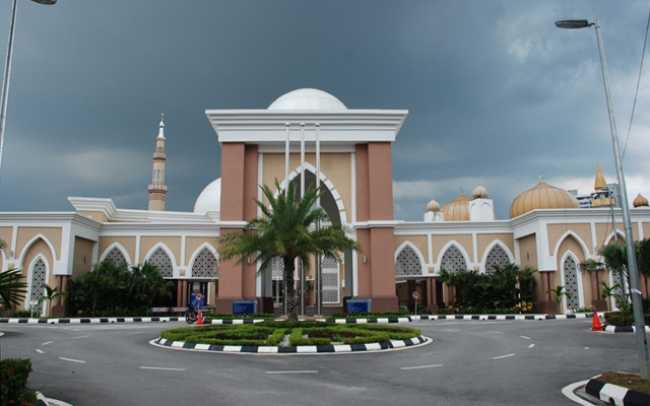The right tools for the job
Published: WORSHIP

MALAYSIA: Acousticon Sdn Bhd has recently completed an installation at Khalid Al-Walid Mosque in Kuala Lumpur. A newly designed sound system comprised of Biamp, AKG, and TOA Electronics equipment was installed to combat issues of extreme reverberation.
Achieving a great acoustical environment can be somewhat of a luxury for Houses of Worship in the 21st Century. In Malaysia, consideration of the acoustics inside mosques usually happens in the later stage of construction after major building work has already been completed. Because of this shortcoming, many of the sound systems installed into mosques nowadays (especially the large ones) suffer from severe speech intelligibility and clarity issues.
The Khalid Al-Walid Mosque was no exception to this problem. With a congregation capacity of up 10,000 the mosque is the largest to have been built by its owners, Ministry of Defence (MINDEF) Malaysia. Just two years after the building work was completed, the decision was made to upgrade the sound system due to inadequate intelligibility of speech during preaching or prayer activity.
The mosque called upon Acousticon Sdn Bhd, Malaysian mosque sound specialist, and entrusted the company to analyse the building and design a solution that improves intelligibility in the main prayer hall.
‘It took almost one week for us to study the existing system and perform the acoustical measurements including reverberation time, STI quality rating, SPL loudness level, and noise rating,’ reports Azizi Ala, technical director of Acousticon Sdn Bhd. ‘The reverberation time (RT60) measured was 3.2s and 0.43 is the highest STI rating that the system can deliver within this reverb environment.’
The team immediately noticed that the previous system installed in the mosque was not intended to be used for speech reinforcement, but was originally designed for paging purposes only. According to Mr Ala, ‘this is a common mistake that often occurs in Malaysia. Paging systems designed for high-rise buildings are installed into a mosque with the hope that they can deliver crystal clear sound quality.’ In the case of Khalid Al-Walid Mosque, a combination of inappropriate equipment, lack of a processing unit, improper speaker location/installation and improper wiring/zoning were all contributing to the appalling sound coverage.
Aided by Ease 4.3 acoustical simulation software, the team were able to model how upgrading, adding, relocating and controlling different speakers affected the sound intelligibility, and after several simulation tests using different speakers and different configurations, the team eventually found a design that provided a homogenous SPL result throughout the hall.
In order to guarantee that the new-upgraded sound system was capable of achieving the simulated environment, a major revamp of the original equipment was proposed. Installation took approximately one month to complete, and included dismantling the existing equipment, supplying and installing the new systems, interfacing with existing equipment, rewiring works, testing and commissioning.
‘The system installed was something new for mosques in Malaysia. It was totally digital from mixer to amplifier, and has fully automatic features,’ explains Mr Ala. ‘We believe that using this type of equipment can solve most of the common problems attributed to acoustics and operator error.’
The equipment that Acousticon installed into the mosque includes a TOA D-901 digital mixer, Biamp Nexia SP audio processor, TOA DA-250FH digital amplifier and D5S, GN ESP series, and CK97C/L AKG microphones. TOA Electronics Sdn Bhd supplied TOA equipment and AKG mics were supplied by Mahajak Trio Electronic Sdn Bhd.
‘Our biggest challenge was how to tame this highly reverberant environment, as the main prayer hall walls are made from glass panels with aluminium frames,’ Mr Ala continues. ‘Any passive acoustic treatment was prohibited and impossible to implement in the venue since the aesthetics are our client’s main concern.
16 TOA SR-H series directional speakers were supplied to increase sound directivity towards the audience without introducing unwanted reflection from the glass walls. The speakers could not be mounted on the walls in the usual fashion because of their unique architectural design, so 1.2m customised floor stand brackets were manufactured to house them.
The last hurdle for the team was to separate the existing circuits inside the main payer hall and create a multiple layer of zoning to accommodate tuning flexibility. This last step proved particularly difficult for the them as the mosque was fitted with marble carvings and Islamic architectural art throughout.
This is the first mosque installation that Acousticon has designed using all digital equipment and including high-tech features such as touch screen navigation panels, voice selection presets, and remote power management. The final result achieved a very impressive minimum STI rating of 0.56, beyond the expected design target of 0.52.
According to Lieutenant Colonel Baharizan Zainal Abidin, officer in charge from Kor Agama Angkatan Tentera (KAGAT), the mosque ‘is very satisfied with the improved result, not least because of the very user friendly and high-tech features it now offers.’
‘We expect this kind of digital concept will be setting a new benchmark for mosque sound systems, and will fulfil the market’s needs in line with changing sound technology,’ a content Mr Ala concludes.
www.acousticon.com.my
www.biamp.com
www.mahajaktrio.com
www.toamys.com.my
